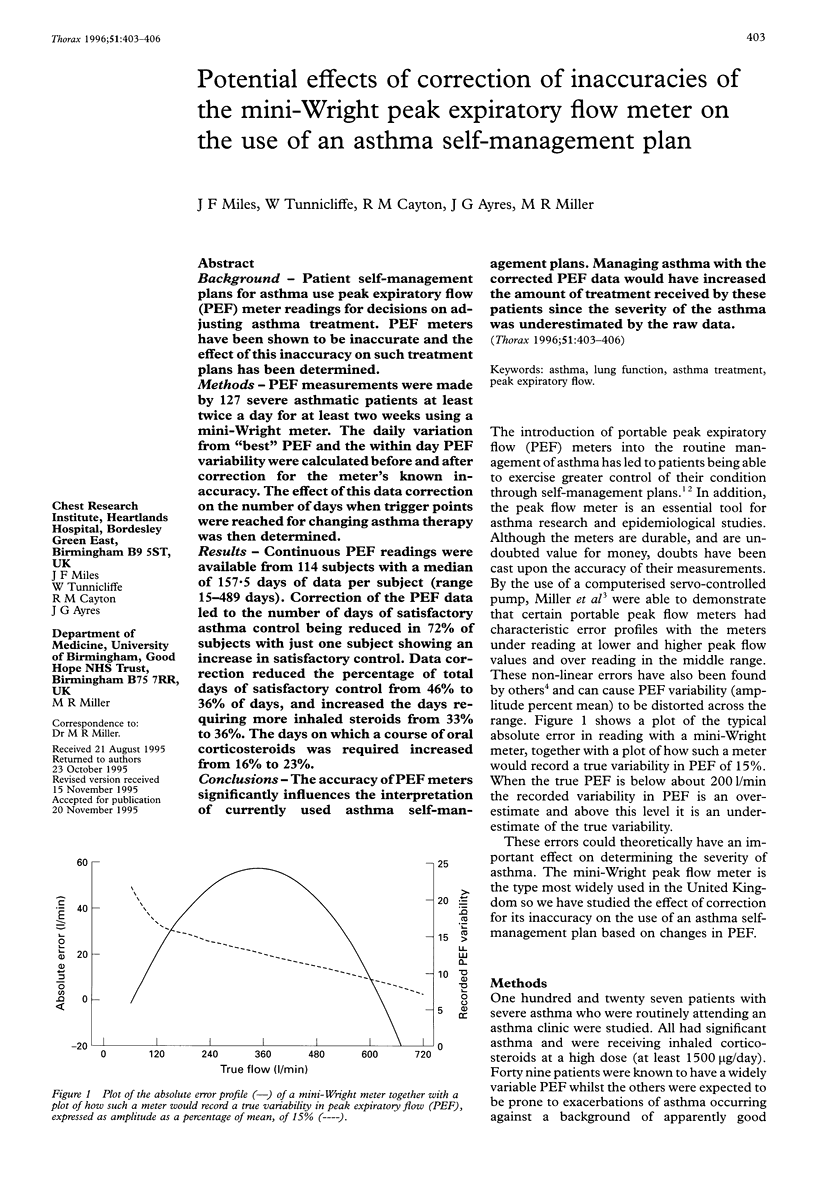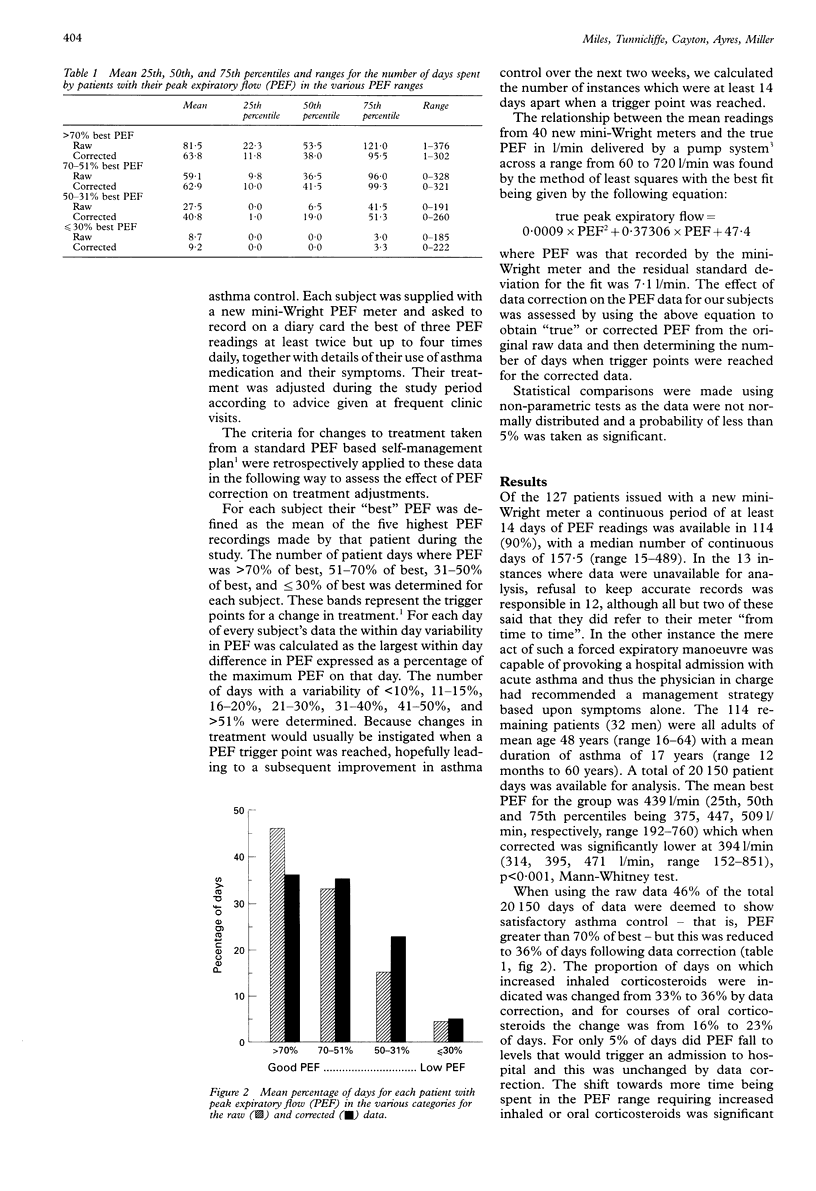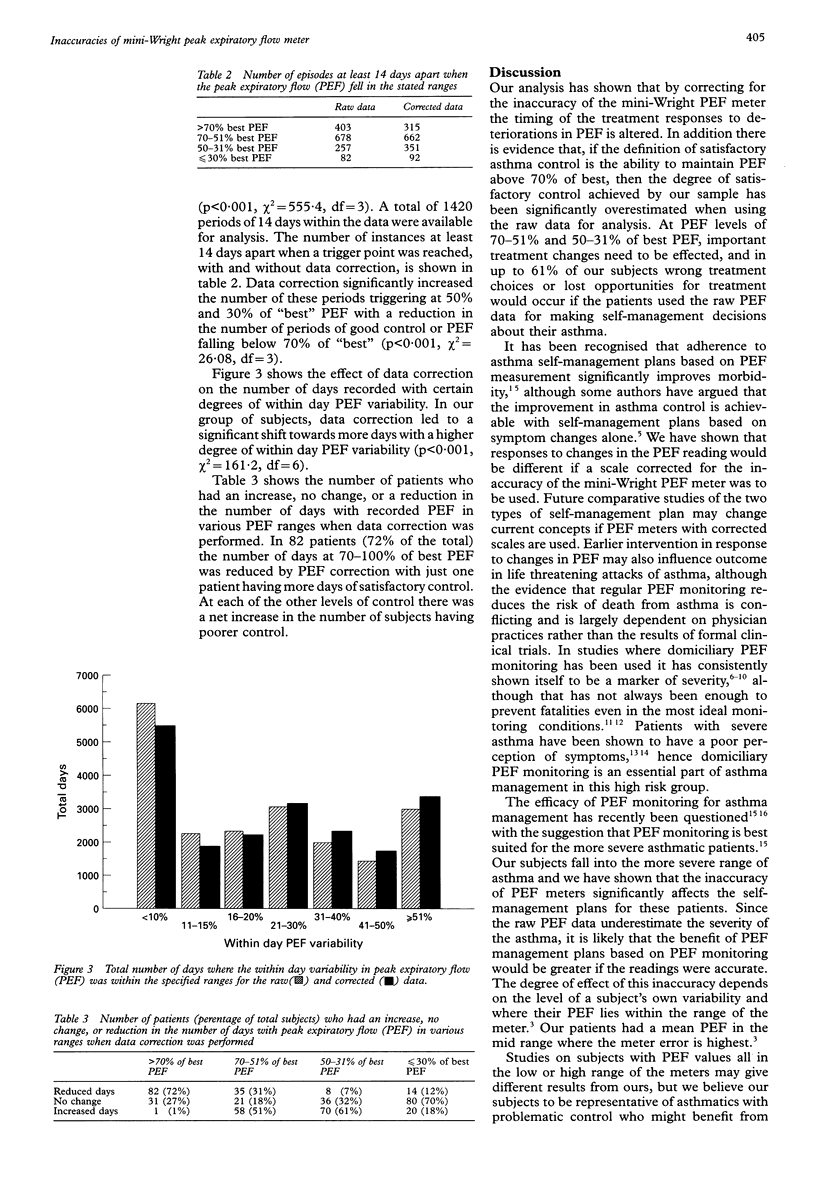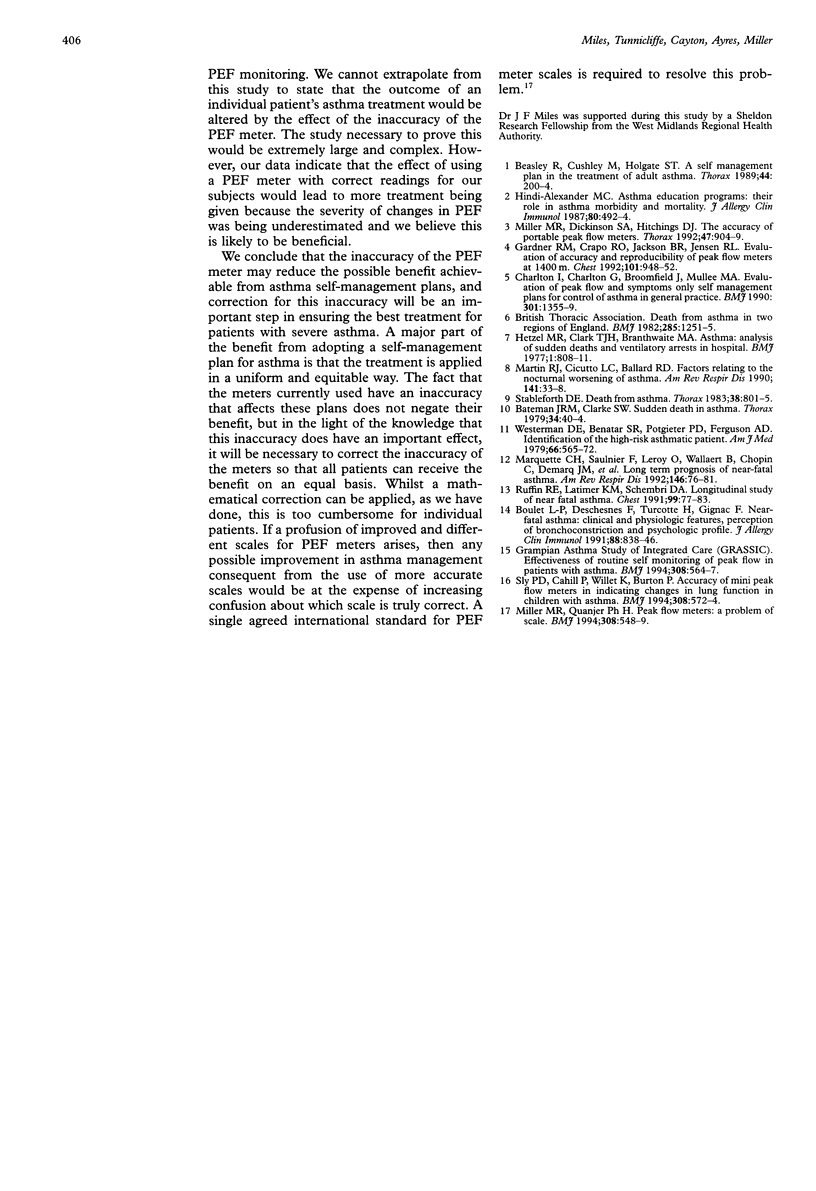Abstract
BACKGROUND: Patient self-management plans for asthma use peak expiratory flow (PEF) meter readings for decisions on adjusting asthma treatment. PEF meters have been shown to be inaccurate and the effect of this inaccuracy on such treatment plans has been determined. METHODS: PEF measurements were made by 127 severe asthmatic patients at least twice a day for at least two weeks using a mini-Wright meter. The daily variation from "best" PEF and the within day PEF variability were calculated before and after correction for the meter's known inaccuracy. The effect of this data correction on the number of days when trigger points were reached for changing asthma therapy was then determined. RESULTS: Continuous PEF readings were available from 114 subjects with a median of 157.5 days of data per subject (range 15-489 days). Correction of the PEF data led to the number of days of satisfactory asthma control being reduced in 72% of subjects with just one subject showing an increase in satisfactory control. Data correction reduced the percentage of total days of satisfactory control from 46% to 36% of days, and increased the days requiring more inhaled steroids from 33% to 36%. The days on which a course of oral corticosteroids was required increased from 16% to 23%. CONCLUSIONS: The accuracy of PEF meters significantly influences the interpretation of currently used asthma self-management plans. Managing asthma with the corrected PEF data would have increased the amount of treatment received by these patients since the severity of the asthma was underestimated by the raw data.
Full text
PDF



Selected References
These references are in PubMed. This may not be the complete list of references from this article.
- Bateman J. R., Clarke S. W. Sudden death in asthma. Thorax. 1979 Feb;34(1):40–44. doi: 10.1136/thx.34.1.40. [DOI] [PMC free article] [PubMed] [Google Scholar]
- Beasley R., Cushley M., Holgate S. T. A self management plan in the treatment of adult asthma. Thorax. 1989 Mar;44(3):200–204. doi: 10.1136/thx.44.3.200. [DOI] [PMC free article] [PubMed] [Google Scholar]
- Boulet L. P., Deschesnes F., Turcotte H., Gignac F. Near-fatal asthma: clinical and physiologic features, perception of bronchoconstriction, and psychologic profile. J Allergy Clin Immunol. 1991 Dec;88(6):838–846. doi: 10.1016/0091-6749(91)90239-k. [DOI] [PubMed] [Google Scholar]
- Charlton I., Charlton G., Broomfield J., Mullee M. A. Evaluation of peak flow and symptoms only self management plans for control of asthma in general practice. BMJ. 1990 Dec 15;301(6765):1355–1359. doi: 10.1136/bmj.301.6765.1355. [DOI] [PMC free article] [PubMed] [Google Scholar]
- Gardner R. M., Crapo R. O., Jackson B. R., Jensen R. L. Evaluation of accuracy and reproducibility of peak flowmeters at 1,400 m. Chest. 1992 Apr;101(4):948–952. doi: 10.1378/chest.101.4.948. [DOI] [PubMed] [Google Scholar]
- Hetzel M. R., Clark T. J., Branthwaite M. A. Asthma: analysis of sudden deaths and ventilatory arrests in hospital. Br Med J. 1977 Mar 26;1(6064):808–811. doi: 10.1136/bmj.1.6064.808. [DOI] [PMC free article] [PubMed] [Google Scholar]
- Hindi-Alexander M. C. Asthma education programs: their role in asthma morbidity and mortality. J Allergy Clin Immunol. 1987 Sep;80(3 Pt 2):492–494. doi: 10.1016/0091-6749(87)90083-2. [DOI] [PubMed] [Google Scholar]
- Marquette C. H., Saulnier F., Leroy O., Wallaert B., Chopin C., Demarcq J. M., Durocher A., Tonnel A. B. Long-term prognosis of near-fatal asthma. A 6-year follow-up study of 145 asthmatic patients who underwent mechanical ventilation for a near-fatal attack of asthma. Am Rev Respir Dis. 1992 Jul;146(1):76–81. doi: 10.1164/ajrccm/146.1.76. [DOI] [PubMed] [Google Scholar]
- Martin R. J., Cicutto L. C., Ballard R. D. Factors related to the nocturnal worsening of asthma. Am Rev Respir Dis. 1990 Jan;141(1):33–38. doi: 10.1164/ajrccm/141.1.33. [DOI] [PubMed] [Google Scholar]
- Miller M. R., Dickinson S. A., Hitchings D. J. The accuracy of portable peak flow meters. Thorax. 1992 Nov;47(11):904–909. doi: 10.1136/thx.47.11.904. [DOI] [PMC free article] [PubMed] [Google Scholar]
- Miller M. R., Ouanjer P. H. Peak flow meters: a problem of scale. BMJ. 1994 Feb 26;308(6928):548–549. doi: 10.1136/bmj.308.6928.548. [DOI] [PMC free article] [PubMed] [Google Scholar]
- Ruffin R. E., Latimer K. M., Schembri D. A. Longitudinal study of near fatal asthma. Chest. 1991 Jan;99(1):77–83. doi: 10.1378/chest.99.1.77. [DOI] [PubMed] [Google Scholar]
- Sly P. D., Cahill P., Willet K., Burton P. Accuracy of mini peak flow meters in indicating changes in lung function in children with asthma. BMJ. 1994 Feb 26;308(6928):572–574. doi: 10.1136/bmj.308.6928.572. [DOI] [PMC free article] [PubMed] [Google Scholar]
- Stableforth D. Death from asthma. Thorax. 1983 Nov;38(11):801–805. doi: 10.1136/thx.38.11.801. [DOI] [PMC free article] [PubMed] [Google Scholar]
- Westerman D. E., Benatar S. R., Potgieter P. D., Ferguson A. D. Identification of the high-risk asthmatic patient. Experience with 39 patients undergoing ventilation for status asthmaticus. Am J Med. 1979 Apr;66(4):565–572. doi: 10.1016/0002-9343(79)91165-3. [DOI] [PubMed] [Google Scholar]


